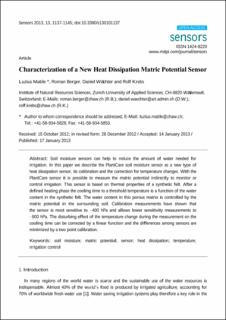Please use this identifier to cite or link to this item:
https://doi.org/10.21256/zhaw-4031Full metadata record
| DC Field | Value | Language |
|---|---|---|
| dc.contributor.author | Jean Petit Matile, Luzius | - |
| dc.contributor.author | Berger, Roman | - |
| dc.contributor.author | Wächter, Daniel | - |
| dc.contributor.author | Krebs, Rolf | - |
| dc.date.accessioned | 2018-10-17T06:40:36Z | - |
| dc.date.available | 2018-10-17T06:40:36Z | - |
| dc.date.issued | 2013 | - |
| dc.identifier.issn | 1424-8220 | de_CH |
| dc.identifier.issn | 1424-8239 | de_CH |
| dc.identifier.uri | https://digitalcollection.zhaw.ch/handle/11475/11889 | - |
| dc.description.abstract | Soil moisture sensors can help to reduce the amount of water needed for irrigation. In this paper we describe the PlantCare soil moisture sensor as a new type of heat dissipation sensor, its calibration and the correction for temperature changes. With the PlantCare sensor it is possible to measure the matric potential indirectly to monitor or control irrigation. This sensor is based on thermal properties of a synthetic felt. After a defined heating phase the cooling time to a threshold temperature is a function of the water content in the synthetic felt. The water content in this porous matrix is controlled by the matric potential in the surrounding soil. Calibration measurements have shown that the sensor is most sensitive to -400 hPa and allows lower sensitivity measurements to -800 hPa. The disturbing effect of the temperature change during the measurement on the cooling time can be corrected by a linear function and the differences among sensors are minimized by a two point calibration. | de_CH |
| dc.language.iso | en | de_CH |
| dc.publisher | MDPI | de_CH |
| dc.relation.ispartof | Sensors | de_CH |
| dc.rights | http://creativecommons.org/licenses/by-nc-sa/3.0/ | de_CH |
| dc.subject | Soil moisture | de_CH |
| dc.subject | Matric potential | de_CH |
| dc.subject | Sensor | de_CH |
| dc.subject | Heat dissipation | de_CH |
| dc.subject | Temperature | de_CH |
| dc.subject | Irrigation control | de_CH |
| dc.subject.ddc | 600: Technik | de_CH |
| dc.title | Characterization of a new heat dissipation matric potential sensor | de_CH |
| dc.type | Beitrag in wissenschaftlicher Zeitschrift | de_CH |
| dcterms.type | Text | de_CH |
| zhaw.departement | Life Sciences und Facility Management | de_CH |
| zhaw.organisationalunit | Institut für Umwelt und Natürliche Ressourcen (IUNR) | de_CH |
| dc.identifier.doi | 10.21256/zhaw-4031 | - |
| dc.identifier.doi | 10.3390/s130101137 | de_CH |
| dc.identifier.pmid | 23344384 | de_CH |
| zhaw.funding.eu | No | de_CH |
| zhaw.issue | 1 | de_CH |
| zhaw.originated.zhaw | Yes | de_CH |
| zhaw.pages.end | 1145 | de_CH |
| zhaw.pages.start | 1137 | de_CH |
| zhaw.publication.status | publishedVersion | de_CH |
| zhaw.volume | 13 | de_CH |
| zhaw.publication.review | Peer review (Publikation) | de_CH |
| zhaw.webfeed | Bodenökologie | de_CH |
| Appears in collections: | Publikationen Life Sciences und Facility Management | |
Files in This Item:
| File | Description | Size | Format | |
|---|---|---|---|---|
| sensors-13-01137.pdf | 702.29 kB | Adobe PDF |  View/Open |
Show simple item record
Jean Petit Matile, L., Berger, R., Wächter, D., & Krebs, R. (2013). Characterization of a new heat dissipation matric potential sensor. Sensors, 13(1), 1137–1145. https://doi.org/10.21256/zhaw-4031
Jean Petit Matile, L. et al. (2013) ‘Characterization of a new heat dissipation matric potential sensor’, Sensors, 13(1), pp. 1137–1145. Available at: https://doi.org/10.21256/zhaw-4031.
L. Jean Petit Matile, R. Berger, D. Wächter, and R. Krebs, “Characterization of a new heat dissipation matric potential sensor,” Sensors, vol. 13, no. 1, pp. 1137–1145, 2013, doi: 10.21256/zhaw-4031.
JEAN PETIT MATILE, Luzius, Roman BERGER, Daniel WÄCHTER und Rolf KREBS, 2013. Characterization of a new heat dissipation matric potential sensor. Sensors. 2013. Bd. 13, Nr. 1, S. 1137–1145. DOI 10.21256/zhaw-4031
Jean Petit Matile, Luzius, Roman Berger, Daniel Wächter, and Rolf Krebs. 2013. “Characterization of a New Heat Dissipation Matric Potential Sensor.” Sensors 13 (1): 1137–45. https://doi.org/10.21256/zhaw-4031.
Jean Petit Matile, Luzius, et al. “Characterization of a New Heat Dissipation Matric Potential Sensor.” Sensors, vol. 13, no. 1, 2013, pp. 1137–45, https://doi.org/10.21256/zhaw-4031.
Items in DSpace are protected by copyright, with all rights reserved, unless otherwise indicated.